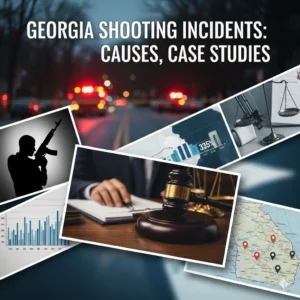Georgia Shooting: Understanding the Incidents, Impacts, and Solutions
Gun violence remains one of the most serious challenges in the United States. In Georgia, a number of high-profile shootings in recent years have shocked communities, raised legal and policy questions, and triggered debates around school safety, mental health, law enforcement, and gun control. This article explores major Georgia shootings, investigates root causes, examines the aftermath, and suggests solutions for prevention.
Key Case Studies in Georgia Shootings
To understand the broader picture, let’s examine two of the most significant recent shooting incidents in Georgia.
1. Apalachee High School Shooting (September 4, 2024)
-
What happened: A 14-year-old student, Colt Gray, opened fire at Apalachee High School in Winder, Georgia. He killed four people (two students and two teachers) and wounded nine others. CBS News+2AJC+2
-
Weapon & technique: The device used was an AR-platform style rifle. Wikipedia+1
-
Afterwards: The suspect was arrested and treated as an adult. The tragedy triggered widespread calls for stronger school security and better oversight of threats made by minors. Reuters+2AJC+2
2. CDC / Emory University Area Shooting (August 8, 2025)
-
What happened: A gunman opened fire near the U.S. Centers for Disease Control and Prevention (CDC) headquarters in Atlanta. A DeKalb County Police Officer, David Rose, was fatally wounded responding to the call. The suspect was found dead inside a CVS Pharmacy across the street. Georgia Recorder+3ABC News+3Wikipedia+3
-
Impacts: Several CDC buildings were hit; windows and exteriors suffered damage. The campus of Emory University and the CDC were locked down; people nearby were ordered to shelter in place. ABC News+2CBS News+2
-
Investigation: Over 500 shell casings found; four firearms recovered including rifles and a shotgun. Authorities are still investigating motive and whether other factors (mental health, access to firearms) played a role. CBS News+2Wikipedia+2
Contributing Factors Behind Georgia Shootings
From these and other incidents, certain recurring patterns emerge. Understanding them is key in developing preventive strategies.
-
Access to High-Powered Firearms
Many of the fatal shootings involve semi-automatic rifles or AR-style weapons, which escalate lethality. Access to these weapons—and in some cases lack of adequate secure storage—raises risk. -
Threats & Warning Signs
In Apalachee, the suspect had been previously investigated for threats online, but no charge was made at that time. This raises the question of how warnings are assessed and how preventive action is taken. PBS+1 -
School & Institutional Security
Features like panic button IDs, school resource officers, lockdown protocols, and monitoring are being used but sometimes are too little, too late. Wikipedia+1 -
Law Enforcement Responses & Coordination
Rapid law enforcement intervention has prevented further casualties in many cases. However, questions remain about how quickly information is shared, how first responders are trained for active shooter situations, and how mental health or domestic issues are factored into incident prevention. -
Mental Health, Community & Social Factors
Underlying issues like mental health crises, social isolation, bullying, or domestic violence often precede violent incidents. Community awareness and support systems are therefore essential in prevention.
Impacts: Beyond the Immediate Tragedy
A shooting’s effects extend far beyond the victims and the physical damage. Some of the long-term impacts include:
-
Trauma among survivors, witnesses & community members
Students, teachers, law enforcement and residents often suffer PTSD, anxiety, grief, and long-term emotional distress. -
Economic & educational disruption
Schools shut down, security measures increase, parents and staff must cope with fear. Often less measurable but deeply felt. -
Policy & legal fallout
Incidents lead to debates on gun laws, school security protocols, mental health funding, and law enforcement oversight. -
Media & societal perception
Public focus on shootings shapes perceptions of safety, trust in institutions, and social cohesion.
Prevention Strategies: What Works
To reduce incidents like those above and their harmful effects, a multi-pronged approach is needed.
| Strategy | Description | Examples / Best Practices |
|---|---|---|
| Stronger Legislation & Gun Safety Laws | Expand background checks; regulate semi-automatic rifle access; enforce secure storage laws. | States with stricter gun laws see lower rates of mass shootings. |
| Early Warning and Threat Assessment Teams | Schools, law enforcement, and mental health professionals working together to assess threats. | The Apalachee case shows importance of acting on warnings. |
| Enhanced School Security Tools | Panic buttons, secure doors, resource officers, emergency drills. | Use of panic-button ID system in Apalachee helped identify and respond. Wikipedia+1 |
| Law Enforcement Training & Rapid Response Plans | Active shooter training, better coordination, regular drills, and public alert systems. | “Run, hide, fight” messaging during CDC-Emory shooting incident. ABC News+1 |
| Mental Health Resources & Community Support | Accessible counseling, anonymous hotlines, school counselors, strengthening social supports. |
How Georgia Is Responding – Policy & Community Action
-
Georgia Bureau of Investigation (GBI) and other state/local agencies are increasing active shooter drills, threat assessment protocols, and reactive capabilities. Georgia Bureau of Investigation+2AJC+2
-
School districts are reviewing security policies, introducing panic-button IDs, enhancing school resource officers’ roles. Wikipedia+2CBS News+2
-
Local communities are organizing vigils, support groups, and collaboratives to help victims and promote awareness.
Your Role: What Individuals & Communities Can Do
-
Stay alert: Take threats seriously—online posts, somewhat vague warnings can sometimes escalate.
-
Secure firearms: If you own guns, lock them up; limit access especially in homes with minors.
-
Advocate: Push local lawmakers to pass sensible gun control laws and funding for mental health.
-
Support victims: Donate to legal and counseling support, blogs and platforms sharing stories can help reduce stigma.
Live Link Example
Here’s a visual example relevant to Georgia shooting incidents:
Live image related to Georgia shooting
Internal Resources & Further Reading
For more insights into crime, community safety, and how internet visibility helps information dissemination, check out posts on your site: RankRise1 Safety & Crime Awareness which explores local-to-global perspectives on security, journalism, and policy.
Conclusion
Georgia’s recent shootings—from school campuses to civic spaces—highlight the urgent need to combine legislative policy, improved security, mental health support, and community vigilance. While no single measure can prevent all tragedies, a holistic approach can reduce both frequency and severity. By understanding past incidents, we become better equipped to build safer schools, workplaces, and neighborhoods.
References
-
“4 dead, 9 hospitalized after shooting at high school in Georgia; 14-year-old suspect in custody.” CBS News. CBS News
-
“Georgia high school student, 14, kills 4 and wounds 9 in campus shooting.” Reuters. Reuters
-
“Officer killed, suspect identified in shooting near CDC headquarters, Emory University campus.” ABC News. ABC News+2Wikipedia+2
-
Georgia Bureau of Investigation press releases on school shootings & officer-involved shootings. Georgia Bureau of Investigation+2Georgia Bureau of Investigation+2

